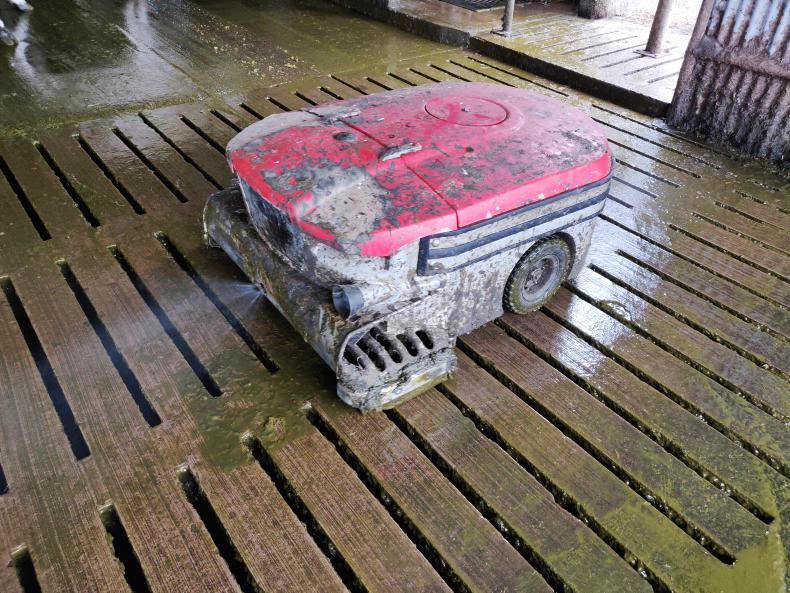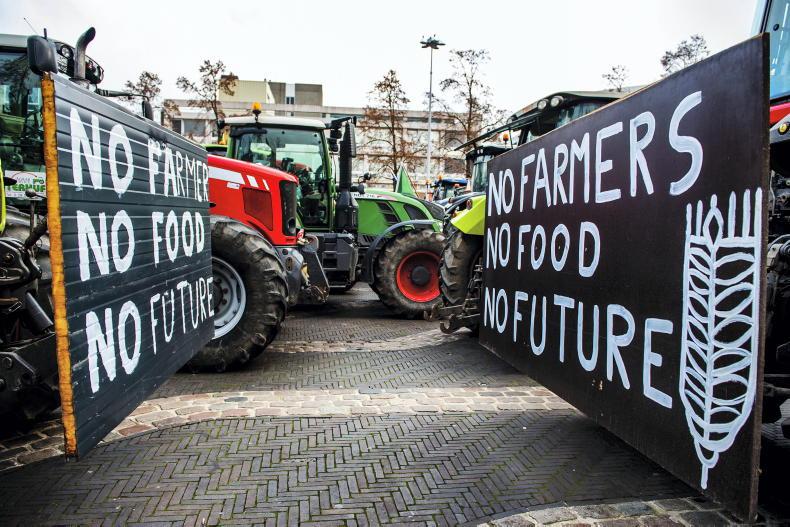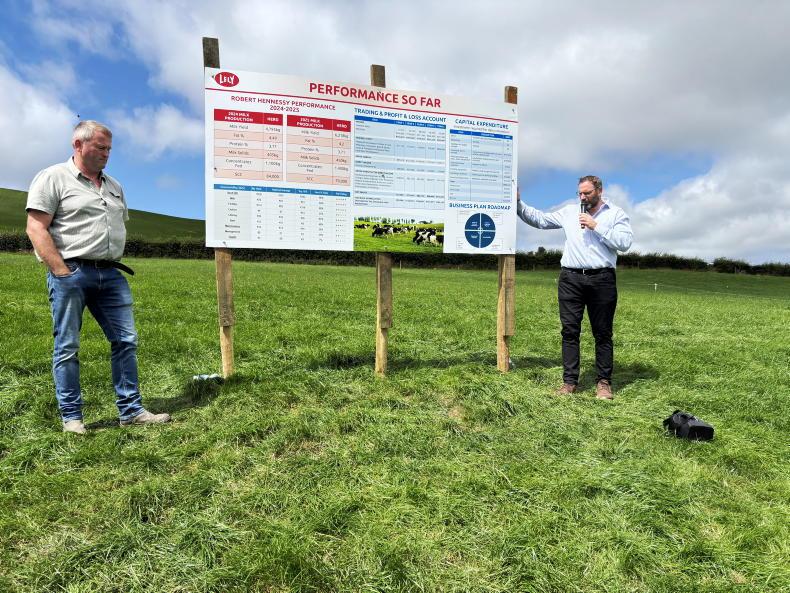Denis Condron recently installed a Lely Discovery Collector robotic yard cleaner in his cubicle shed. The farm converted from sucklers to dairy four years ago, installing two robotic milking machines for the 110-cow herd. As is the case for many farmers who adapt existing sheds, the layout did not suit installing scrapers down the length of the passageways due to the location of slatted tanks. This meant Denis used a tractor-mounted scraper to clean the shed.
“We had looked at putting in traditional scrapers but there is a large solid area in front of the two robots that they would not have cleaned so we needed to look at other options,” Denis said. “I had seen this machine at the Ploughing and it suited what we needed.”
Unlike the smaller Lely Discovery that pushes slurry to the nearest tank, the Collector vacuums up the slurry and will either dump it over the slatted tank or at its charging station.

Before.
During the summer months the cows will have access to a large slatted passageway and the solid area in front of the robots.

After.
Therefore, during the summer months the collector is put on a summer route and only covers these two areas of the shed. When moving over the slatted area, it acts as a scraper, pushing slurry into the tank. When it goes over the solid area the vacuum is programmed to kick in.
Maintenance
Niall McGauran of Lely Center Mullingar said: “The machine would generally use two sets of blades during the year but this depends if it is going over slats or rough concrete. The majority of the maintenance the farmer can generally carry out themselves.” Niall would recommend to have the collector carrying out a route every two to three hours. “If you do it regularly and don’t let it build up too much the system works better.”

The Collector has a charging station where it will dock. Here it can dump collected slurry, recharge and fill with water.
The tank in the collector has capacity for 300 litres of slurry. Additionally, there is also a smaller tank that is filled with water before the robot takes off on its route around the shed. Water is then sprayed in front of the collector, to soften slurry, resulting in better slurry intake. Spraying from the back ensures a wet floor to provide additional grip.
Lely Discovery
Alongside the Discovery Collector, there is also the standard Lely Discovery that just pushes slurry to the nearest tank. This would not have suited this shed as the tank runs down along one side of the shed and slurry channels would be required running across the shed.
According to Niall, the longest distance they have gone from a tank to a tank/slurry channel is five bays, which was manageable.
The cost of the smaller Lely Discovery is €13,500 plus VAT. This increases to €25,000 plus VAT for the Discovery Collector model seen here.
Comment
From seeing the system in action, the vacuum is capable of dealing with large volumes of slurry effectively. It is not a small investment, but the cost of altering old sheds to install slurry channels for conventional scrapers is not a small one either. For this farm, cows will be walking to the robots over 220 times per day so one of the main issues can be trying to keep the area in front of the robots clean, particularly where there is no slatted tank in place. The longevity of the Collector will be the real test for the system but it does have a place, particularly for converted sheds.
Denis Condron recently installed a Lely Discovery Collector robotic yard cleaner in his cubicle shed. The farm converted from sucklers to dairy four years ago, installing two robotic milking machines for the 110-cow herd. As is the case for many farmers who adapt existing sheds, the layout did not suit installing scrapers down the length of the passageways due to the location of slatted tanks. This meant Denis used a tractor-mounted scraper to clean the shed.
“We had looked at putting in traditional scrapers but there is a large solid area in front of the two robots that they would not have cleaned so we needed to look at other options,” Denis said. “I had seen this machine at the Ploughing and it suited what we needed.”
Unlike the smaller Lely Discovery that pushes slurry to the nearest tank, the Collector vacuums up the slurry and will either dump it over the slatted tank or at its charging station.

Before.
During the summer months the cows will have access to a large slatted passageway and the solid area in front of the robots.

After.
Therefore, during the summer months the collector is put on a summer route and only covers these two areas of the shed. When moving over the slatted area, it acts as a scraper, pushing slurry into the tank. When it goes over the solid area the vacuum is programmed to kick in.
Maintenance
Niall McGauran of Lely Center Mullingar said: “The machine would generally use two sets of blades during the year but this depends if it is going over slats or rough concrete. The majority of the maintenance the farmer can generally carry out themselves.” Niall would recommend to have the collector carrying out a route every two to three hours. “If you do it regularly and don’t let it build up too much the system works better.”

The Collector has a charging station where it will dock. Here it can dump collected slurry, recharge and fill with water.
The tank in the collector has capacity for 300 litres of slurry. Additionally, there is also a smaller tank that is filled with water before the robot takes off on its route around the shed. Water is then sprayed in front of the collector, to soften slurry, resulting in better slurry intake. Spraying from the back ensures a wet floor to provide additional grip.
Lely Discovery
Alongside the Discovery Collector, there is also the standard Lely Discovery that just pushes slurry to the nearest tank. This would not have suited this shed as the tank runs down along one side of the shed and slurry channels would be required running across the shed.
According to Niall, the longest distance they have gone from a tank to a tank/slurry channel is five bays, which was manageable.
The cost of the smaller Lely Discovery is €13,500 plus VAT. This increases to €25,000 plus VAT for the Discovery Collector model seen here.
Comment
From seeing the system in action, the vacuum is capable of dealing with large volumes of slurry effectively. It is not a small investment, but the cost of altering old sheds to install slurry channels for conventional scrapers is not a small one either. For this farm, cows will be walking to the robots over 220 times per day so one of the main issues can be trying to keep the area in front of the robots clean, particularly where there is no slatted tank in place. The longevity of the Collector will be the real test for the system but it does have a place, particularly for converted sheds.













SHARING OPTIONS